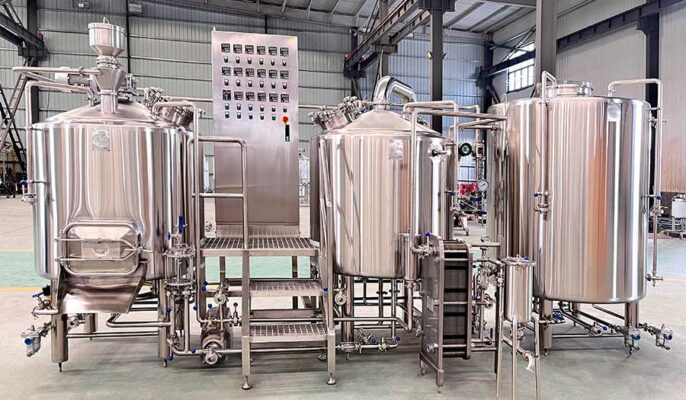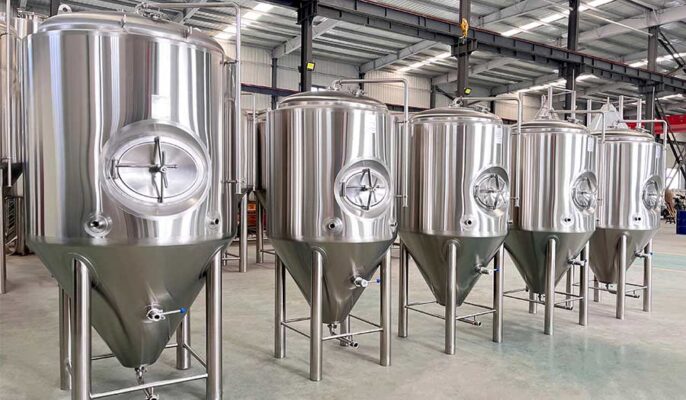5bbl turnkey brewing systems are generally suitable for smaller and independent breweries than commercial breweries, which focus more on flavor and brewing technology. A 5-barrel (BBL) brewery is a medium-sized commercial brewing system with a batch capacity of approximately 155 gallons or 588 liters. The system enables craft breweries to produce high-quality beer at scale for taprooms and local distribution.
What is a 5bbl brewing system?
The 5bbl brewing system is a micro commercial brewing system designed to produce approximately 155 gallons or 590 liters of beer per batch. This is a popular choice for small breweries looking to produce high-quality craft beer without incurring significant costs.
The system is made up of many components, each playing a vital role in the brewing process. The mash tun holds grains and hot water during the mashing process, converting starch into fermentable sugars. After the mashing process, the brewing kettle is used to boil the wort and add hops to develop flavor and aroma.
5bbl brewing systems offer many advantages such as cost-effectiveness, versatility, and compactness. It’s more affordable than larger brewing systems, making it an excellent choice for small businesses and startups. The 5bbl barrel brewing system allows brewers to brew various types of beer, providing customers with more variety. It is also space-saving and suitable for smaller spaces.

5bbl brewing system basic configuration
The main configuration of 5BBL brewing system:
- 300kg/h Malt miller
- Auger
- 5BBL 2 vessels brewhouse with Mash/Lauter tun+Kettle/Whirlpool tank
- Grain hydrator
- 6㎡ heat exchanger
- 3m³/h pumps
- Hops inline filter
- Yeast addition tank
- Oxygenate device
- Indoor exhaust
- 10BBL Hot water tank
- 4*5BBL Unitank
- 1*10BBL Unitank
- 10BBL Glycol water tank
- 6HP Packaged glycol chiller
- PID controller
- Dual can filler and seamer
- 50L CIP cleaning trolley
|
Capacity |
5-1000BBL/Batch |
|
Material |
Stainless steel |
|
Combination method |
Mash/Kettle Tank,Lauter And Whirlpool Connection Tank |
|
Application |
Restaurants, bars, hotels, brewery |
|
Heating way |
Steam heating/Electric heating/Direct fire heating |
|
Voltage |
AC380/220V, 50/60HZ |
|
Degree of automation |
Semi-automatic/Fully automatic |
Advantages of 5bbl Brewing System
- Energy saving, higher brewing efficiency, lower material consumption, and higher wort leaching rate
- automatic mashing, wort, water flow, and automatic temperature control
- designed steam system improves heating efficiency and reduces energy loss
- More reasonable pipeline structure to avoid wort aeration problems and reduce material loss
- The valve body and cone adopt designed jackets to ensure heating and cooling efficiency
- The headspace is large, and the headspace volume needs to be calculated .
- The tank welding adopts a 100% TIG welding process, and the jacket welding adopts full water welding. The jacket is cooled by uniform ripples to ensure no leakage, long life, and passivation of welds!
- The mirror polishing, polishing 6 times to achieve Ra 0.4um mirror finish, can be cleaned 360° without dead corners.
- The sheath is tested for 12 hours, using air and water, the sheath test pressure is 5 bar, and the inner shell test pressure is 4 bar, we will also conduct a 48-hour water test before packaging.
- Strict quality control and process inspection and testing system, all test records will be displayed on our data at the later stage of tank transportation and will be tracked with inspection list and serial number.
- Adhere to the high-end product line to manufacture tanks. All components such as chillers, exchangers, steam boilers, Schneider/ABB electronic control systems, etc. are all made by international brands to ensure quality and convenient after-sales.
5bbl brewing process
- Mash: Ground grains are mixed with hot water in a saccharification barrel to convert starch into sugar. 1-2 hours at temperatures around 155°F (68°C).
- Filtering: Drain the sweet wort from the grains in the mash barrel. The spent grain is discarded and the wort is collected.
- Boiling: Put the wort and hops into a pot and boil for 60-90 minutes. This sterilizes, extracts flavor, and coagulates proteins.
- Vortex: Create a vortex in the wort to separate the spent grains and hops before fermentation.
- Cooling: cool boiling wort below 80°F (27°C) to ferment yeast.
- Fermentation: Yeast ferments sugar into alcohol and carbon dioxide, lasting 1-2 weeks.
- Aging: Beer is aged to develop flavor before being filtered and packaged.
5 BBL automation systems group containers together and automate transfers and temperature control to streamline the process. But the basic brewing stages are the same.
Batch for 5bbl brewing system
- Standard 5 BBL batch produces 155 gallons of wort. So the system can brew 310 gallons in a double batch.
- Typical annual production for a small brewpub would be 500-1000 barrels if operating 1-2 times per week.
- You need enough fermentation and brine tank capacity to accommodate many batches at the same time. Plan for at least 2-3 sets.
- Floor space required varies from 400 sq. ft. for a compact automated system to 1000 sq. ft. for a more dispersed traditional 3-container setup.

|
PARAMETER |
DETAILS |
|
Batch Size |
5 bbls or 155 gallons or 588 liters |
|
Yearly Output |
500-1000 barrels depending on schedule |
|
Fermentation Tanks |
2-3 tanks minimum to ferment batches |
|
Brite Tanks |
1-2 to condition and clarify beer |
|
Floor Space Needed |
400-1000 sq. ft. depending on layout |
Maintenance of brewing systems using 5bbl
Health
One of the most important aspects of brewing beer is hygiene. All equipment, including mash tuns, brew kettles, fermenters and coolers, should be cleaned and sanitized before and after each use. This helps prevent contamination and ensures the beer has a clean taste.
Consistency
When brewing beer with a 5-barrel brewing system, consistency is key. Maintaining consistent brewing methods helps ensure consistent taste and quality of beer.
- Measure your ingredients . Use a scale to measure grains and hops to ensure you are using the correct amounts.
- Use the same brewing procedure for each batch of beer. This includes mashing, boiling, fermentation and conditioning.
- record each batch of beer. This can help you identify any inconsistencies or issues in your brewing process.
Maintain
Regular maintenance of your brewing equipment is essential to ensure that it is working and to avoid malfunctions or malfunctions during the brewing process.
- Check your equipment . Check for any signs of wear and replace any damaged or worn parts.
- Clean your device after each use. This helps prevent corrosion and the build-up of bacteria or other contaminants.
- Use equipment according to manufacturer’s instructions. This helps avoid any damage or malfunction.




